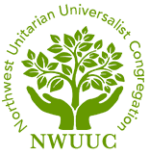Northwest continued a long-time Mother’s Day tradition with the sharing of red and white carnations. A red carnation was offered to people whose mother was still alive and a white carnation to those whose mother had passed away.
Longtime member Hugh Fordyce brought this tradition to Northwest. Hugh’s hometown of Webster, West Virginia was also the home of Anna Jarvis, the founder of Mother’s Day.
In abbreviated remarks from the pulpit, Hugh noted how his parents would point out the home of Anna Jarvis on their walk to church. Hugh shared that following the death of Anna Jarvis’s mother in 1905, Miss Jarvis was determined to honor her mother and other mothers nationwide.
In 1914, President Wilson signed a resolution on declaring Mother’s Day to be the second Sunday in May.
Below are Hugh’s full comments on Anna Jarvis.
Since Anna Jarvis and I were both born in the same small town of Webster, West Virginia, Mother’s Day has a special interest for me. I first heard of Miss Jarvis when we walked to church; my folks often pointed out the house where she was born.
Ann Reeves Jarvis, Anna’s mother, was active in church activities—having taught classes at the Andrews Methodist Church in Grafton, West Virginia, for twenty years; she also made frequent talks on “Great Mother’s in the Bible.” But it was her work to combat poor health and sanitation conditions that most impressed her daughter. She organized small groups of mothers, known as Mothers’ Day Work Clubs, to teach such basics as sterilizing diapers and inspecting milk for infants. During the Civil War when an outbreak of typhoid fever and measles broke out among the opposing armies, Ann Jarvis and her Mothers’ Day Work Clubs were called upon for help. (During the Civil War, more persons died from disease than from wounds on the battlefield.)
Anna Jarvis was born in Webster in 1864—about a year after West Virginia had become a state. She attended Augusta Female Academy (now Mary Baldwin College) in Staunton, Virginia. She often heard her mother say that she hoped that someone would establish a memorial for all mothers, living and dead. Thus, after her mother’s death in 1905 she, along with some friends, reviewed the accomplishments of her mother—particularly, the Mothers’ Day Work Clubs. After this meeting, Miss Jarvis wrote to officials of her mother’s church suggesting that a Mother’s Day should be celebrated annually. Thus, the first Mother’s Day church service was held on May 12, 1907, at the Andrews Methodist Church.
After this initial success, Anna Jarvis found her life cause: the establishment of a national mother’s day. Writing hundreds of letters to legislators and speaking to countless groups in her quest, she was both dedicated and determined. Ultimately, with the help of John Wannamaker, the successful Philadelphia merchant, the movement gained momentum when a joint resolution of Congress designated the second Sunday in May as Mother’s Day. The resolution was signed by President Wilson in 1914.
In 1911, Anna sent 500 carnations to her mother’s old church to be given to those present and to be worn to show love and gratitude to those who gave us birth. She chose carnations because they were her mother’s favorite flower.
Choosing a red or white carnation to honor and remember your mother continues the tradition established by Miss Jarvis–a white carnation if your mother is deceased; a red one if she is still living.

